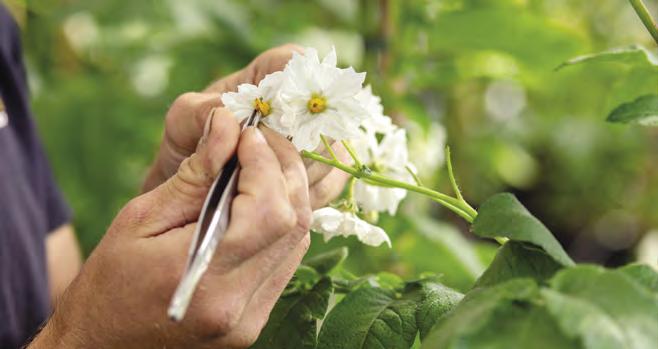
4 minute read
Yes My Lady! Meijer’s Quest for the Perfect Chipping Potato

Yes My Lady!
Advertisement
Meijer’s FAB Quest for the Perfect Chipping Potato
By Austen Dack and Terry Jones
Recently I visited Meijer’s HQ in Holland, I wanted to see for myself the chain of events that need to happen in order for a new variety to make it via the grower, into a fish & chip shop and onto the consumer’s plate. I visited their offices, labs and finally box stores to see first-hand how they continue to develop first class ware capable of beating disease, climate, & law changes, whilst still passing the all-important fry & taste test.
Chip shop owners all have their own specification when sourcing the perfect chipping spud. A clean sample, good shape, low waste, maximum shelf life. The best flesh and fry colour, and of course a great taste! There are many variables to consider – and it’s no different for the grower!
They face their own challenges, based on what a customer needs – along with a changing climate, varying soil types, and any pests or diseases to protect the crop against. At that point, they will approach specialist potato breeders like Meijer Potato and select varieties with the best chance of success.
With constant change in agriculture and business, Meijer are always looking to innovate, the breeding and product development teams are a huge part of this process. Ongoing investment provides the latest technology to focus on delivering results for everyone from the grower to the end consumer.
Variety breeding is a 7–9-year process, from a single plant to large commercial field production. It starts with a flower on a potato plant being pollinated from another flower, this produces berries. The tiny seeds within them are planted, and each plant is now a unique potato variety that is given a numbered identity.
The clever part starts here - a cutting is taken from that single plant, and the DNA analysed. A number of DNA ‘markers’ are searched for, which helps identify the variety characteristics – will it have resistance to certain diseases/ pests etc? In recent years this process


has been speeded up by using robots. Those without any positive traits are discarded – only the best few go forward from hundreds of thousands of plants produced every year. These ‘contenders’ are taken to a glasshouse and are grown on to produce tubers.
Those tubers, planted in trials the next year are again selected, and 3-4 years of worldwide trialling follow to challenge the variety in various climates and soil types. This will usually reduce the number to around 10-15 varieties that are then introduced to customers for their feedback, a vital part of the process to ensure they are creating what the market wants. Finally, a variety that works for everyone goes into full production and gets a name (new chipping varieties at Meijer are always named Lady ‘something’ (Anna, Terra and Jane amongst the newest ones). At that point it’s rewarding for the breeder to see their ‘baby’ out in the big wide world, but they are always working in the background to find something even better!
A walk through their box room shows the fruits of their labour, a culmination of so much hard work & investment. There are many rows of varieties (grown in different types of fields) all of whom must prove not only they are better than those already available via Meijer, but are also immune to the latest disease, or can hold up in storage and reward you the owner with a continuous supply of great chipping potatoes right through the season.
With over 30 separate tests including yield, size, shape, fry colour, dry matter and more, this is the final make or break for each variety and one which determines if each variety makes it onto another year of testing or the holy grail of being named and making it as a new potato brand.
My visit to Meijer was rewarding indeed. To see the passion investment and hard work was a joy. I was lucky enough to meet their MD and many of their staff all of whom were very interested to know about the reasons behind my trip.
This visit once again cements our commitment to follow the arduous journey of the potato all the way from seed to fryer. I would like to personally thank Erika (CEO Meijer) for hosting and Max & Terry for their time showing me around the lab, stores and a visit to a large local seed potato farmer.
www.meijerpotato.co.uk















